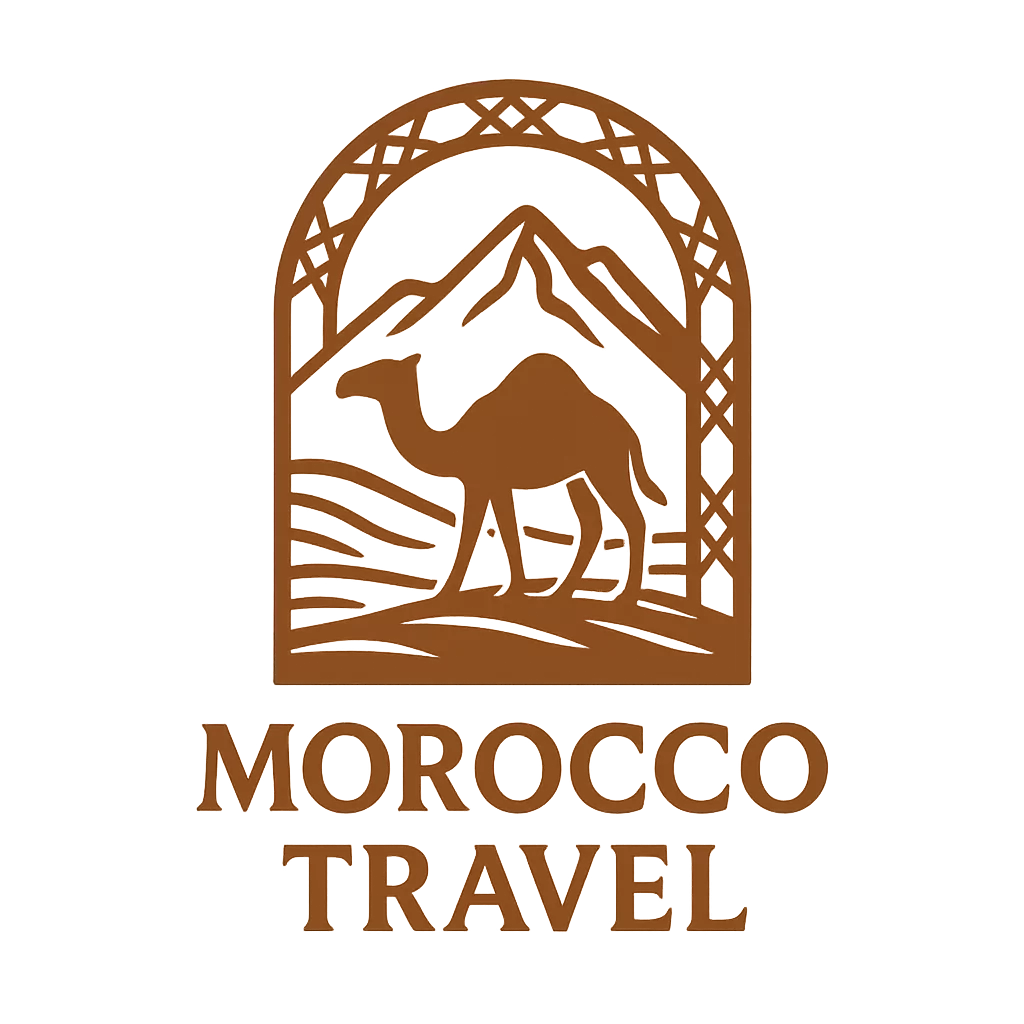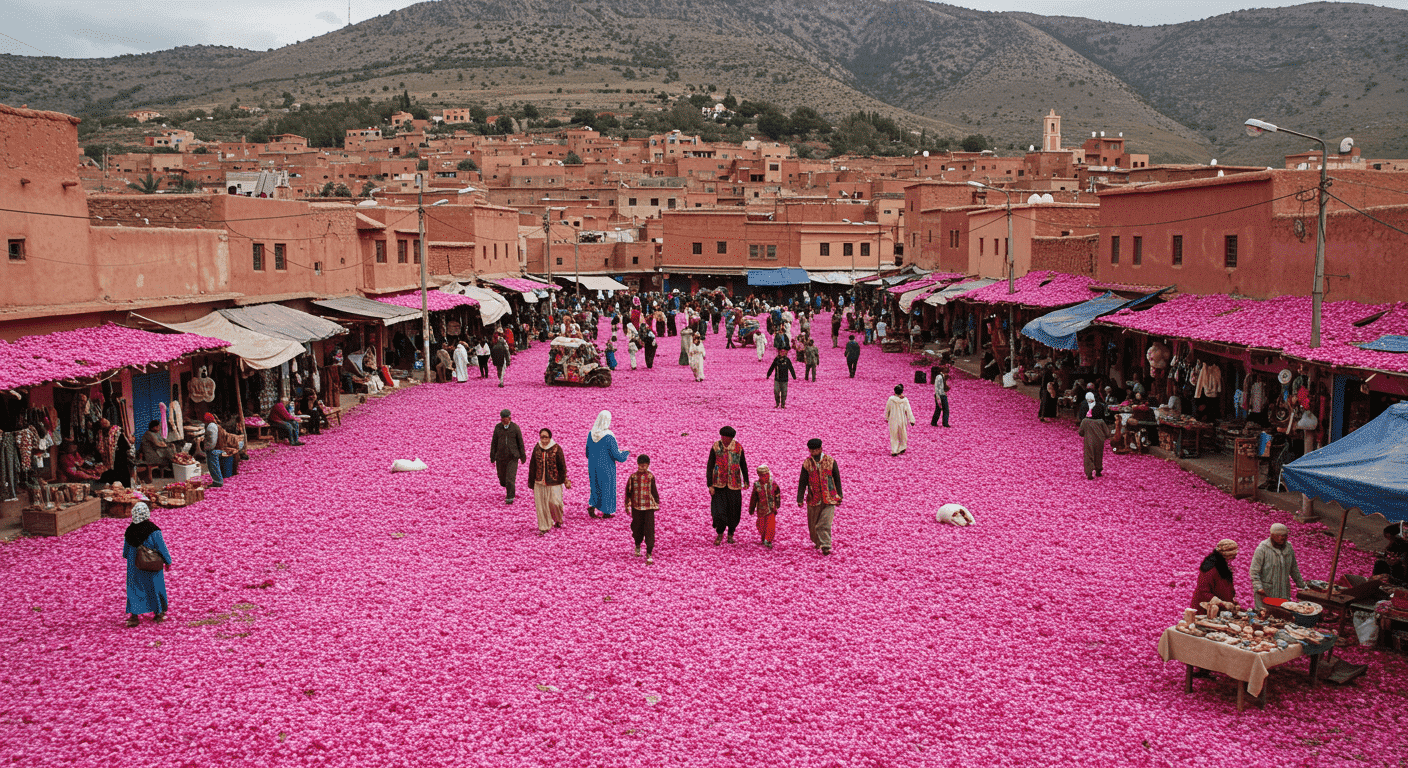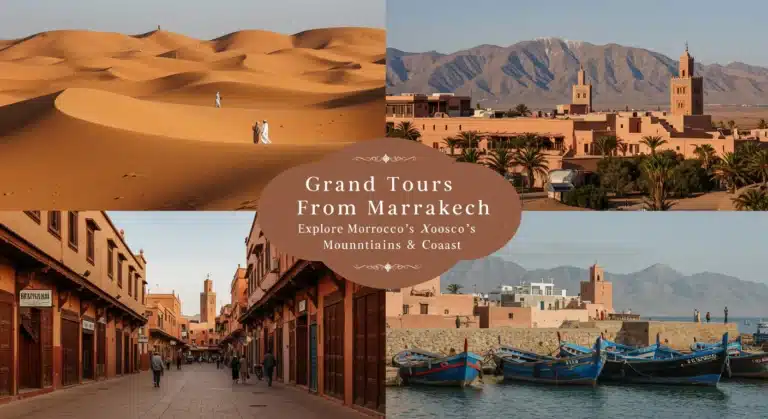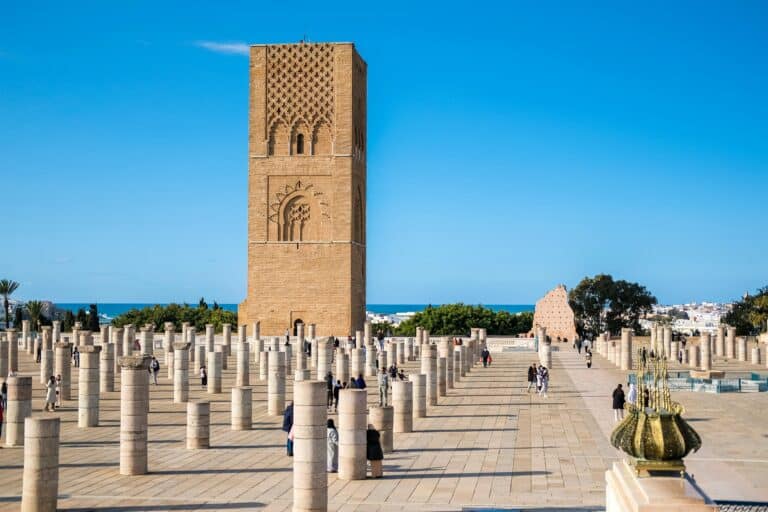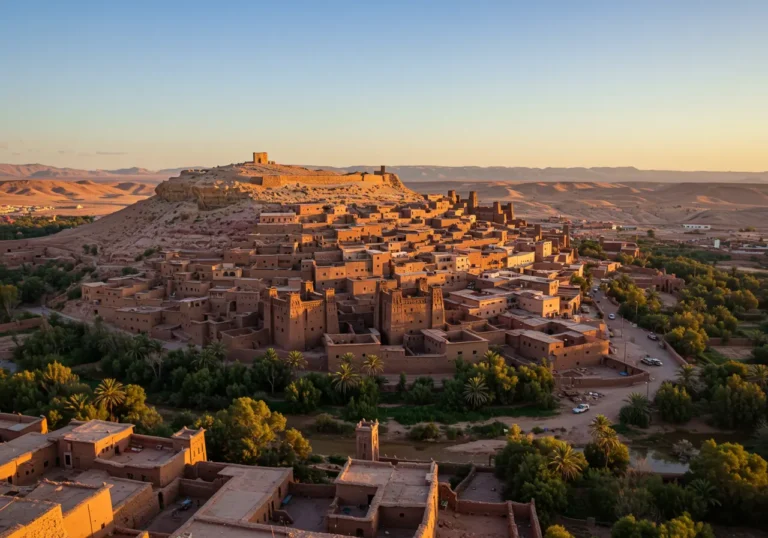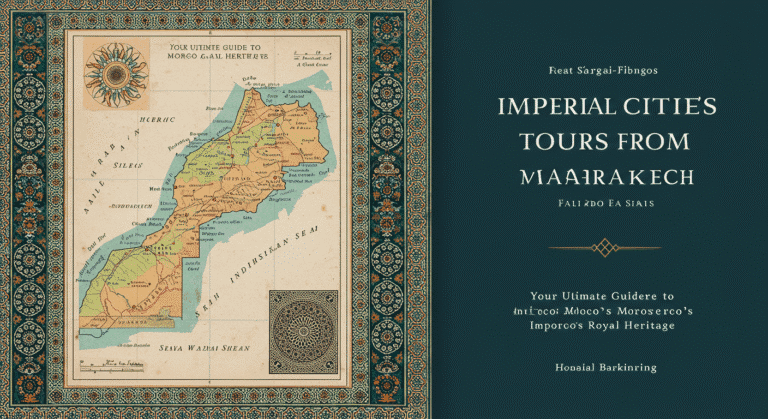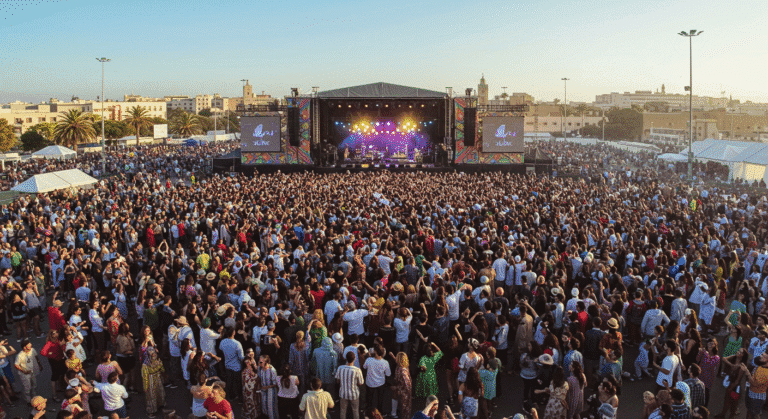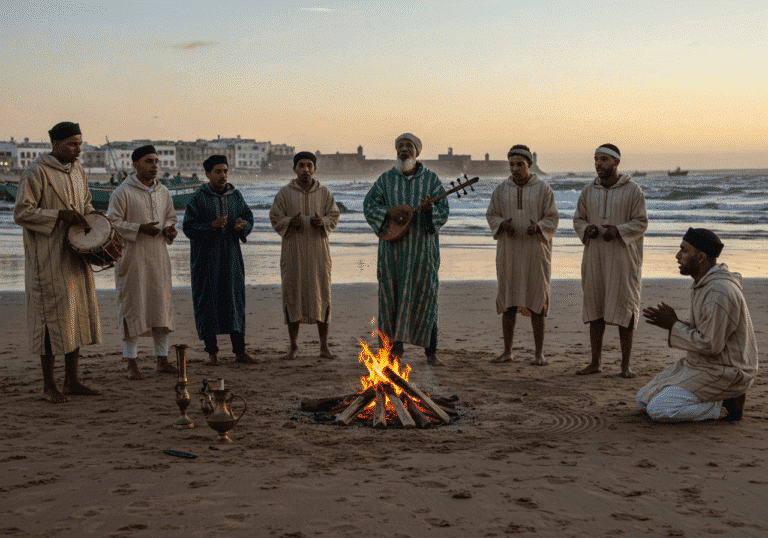Kalaat M’Gouna Rose Festival
Have you ever wondered where the world’s most exquisite rose fragrances originate? While many assume Bulgaria or Turkey holds this distinction, Morocco’s hidden gem, Kalaat M’Gouna, might surprise you as the unsung hero of global rose production. Nestled in the Valley of Roses between the High Atlas Mountains and Jbel Saghro range, Kalaat M’Gouna transforms each May into a sensory paradise during its annual Roses Festival. This small Moroccan town produces over 3,000 tons of rose petals annually, with approximately 20 tons of fragrant blooms required to produce just one liter of precious rose oil. The Kalaat M’Gouna rose harvest supplies prestigious perfumeries worldwide, making this destination not just beautiful but economically significant on a global scale.
Travel Checklist / What to Pack
Preparing properly for your journey to Kalaat M’Gouna will enhance your experience immensely. Here’s what you should pack:
Clothing:
- Lightweight, breathable fabrics for daytime (temperatures can reach 86°F/30°C in May)
- Light jacket or sweater for cooler evenings (desert temperatures drop significantly after sunset)
- Comfortable walking shoes for exploring the rose fields and mountain paths
- Sun hat with wide brim and sunglasses
- Modest clothing that covers shoulders and knees (especially important when visiting rural Moroccan communities)
Essentials:
- High SPF sunscreen (the mountain sun is intense)
- Portable water bottle with filter (stay hydrated while reducing plastic waste)
- Small backpack for day excursions
- Power bank for electronic devices
- Universal adapter (Morocco uses type C and E plugs)
Pro Tips:
- Bring a lightweight scarf that can serve multiple purposes: sun protection, warmth in the evenings, and respect for local customs
- Pack a small bottle of rose oil from home to compare with authentic Kalaat M’Gouna roses
- Consider bringing small gifts if you plan to visit local families (non-religious books, school supplies for children)
- A compact camera with good zoom capabilities will capture the stunning contrast between rose fields and mountain backdrops
Best Time to Visit
While Kalaat M’Gouna captivates visitors year-round with its stunning mountain scenery, the optimal time to experience this rose paradise is unquestionably during the annual Roses Festival in mid-May. This timing coincides perfectly with the rose harvest season when:
- The valley bursts with the vibrant pink of Damascus roses in full bloom
- Temperatures average a pleasant 75°F/24°C during the day
- Visitor numbers are 45% lower than summer peak season (July/August)
- Accommodation prices remain approximately 20% below high season rates
The festival typically spans three days during the second or third weekend of May, though exact dates vary based on the harvest schedule. For travelers seeking a more tranquil experience, consider visiting in early May before the festival begins. You’ll witness the rose fields at their aromatic peak while enjoying even smaller crowds (data shows early May visitation is 60% lower than festival weekend).
For budget travelers, April offers similar natural beauty with roses beginning to bloom, temperatures averaging 68°F/20°C, and accommodation rates approximately 35% lower than during the festival period.
Step-by-Step Itinerary
Day 1: Arrival and Town Exploration
Begin your Kalaat M’Gouna adventure by settling into your accommodation. For an authentic experience, choose a traditional guesthouse (called a “riad”) near the town center. After refreshing, take a leisurely walk through the town’s central square, where many buildings showcase a distinctive rose-pink color.
Visit the Rose Collective building (open 9 AM to 5 PM), where you’ll receive a complimentary introduction to rose production techniques from female artisans who have perfected these methods across generations. Here, you can observe firsthand how rose water and oil are extracted using both traditional and modern distillation methods.
For lunch, stop at Café Panorama on the town’s western edge, where local tagine dishes are served with rose-infused sides. Their signature rosewater lemonade offers perfect refreshment after your morning explorations.
In the afternoon, visit the local souk (market), especially active on Wednesdays. Navigate beyond the tourist stalls to the back section where locals shop. Here, merchants sell rose products at prices approximately 30% lower than in dedicated shops.
Day 2: Rose Valley Excursion
Rise early to experience the rose harvest in action. Between 5 AM and 10 AM, harvesters collect blooms before the sun diminishes their precious oils. Arrange through your accommodation to join local families during this process (typically costs 100-150 Moroccan dirhams, roughly $10-15 USD).
After participating in the harvest, follow the valley road northward for approximately 4 kilometers to reach the hillside viewpoint (marked by a small stone cairn). This spot provides panoramic views of the entire valley floor patterned with rose fields against the dramatic mountain backdrop.
For lunch, visit the family-owned Maison de la Rose (approximately 3km from town center). Their garden restaurant serves traditional Berber dishes, including the regional specialty “rfissa” topped with rose petals.
Spend your afternoon at one of the working rose distilleries. The Cooperative Rosamgoun offers tours in multiple languages (11 AM, 2 PM, and 4 PM daily), demonstrating how 10,000 roses yield just 1 liter of precious rose water.
Day 3: Festival Immersion
Dedicate your third day entirely to festival activities. Begin at the main parade starting at 10 AM, where flower-decorated floats accompanied by traditional Amazigh musicians proceed through town. Position yourself near Hotel Rose to capture the best photographs of this spectacle.
At noon, join the community feast in the central festival grounds. For approximately 200 dirhams ($20 USD), you’ll enjoy a multi-course meal featuring rose-infused dishes alongside local families and visitors.
In the afternoon, attend the Rose Queen competition, where young women from surrounding villages compete based on beauty, knowledge of rose cultivation, and performance of traditional skills. This cultural highlight occurs at the outdoor amphitheater constructed specifically for the festival.
As evening approaches, don’t miss the sunset concert featuring fusion musicians who blend traditional Amazigh melodies with contemporary instruments. These performances typically begin around 7 PM and continue until late evening.
Day 4: Mountain and Cultural Exploration
Contrast your rose experiences with exploration of the surrounding landscapes. Arrange a half-day guided hike through nearby Dades Gorge (approximately 25km from Kalaat M’Gouna). The “Monkey Fingers” rock formation trail offers moderate difficulty with spectacular rewards.
After returning from your hike, visit the Berber cultural center for a hands-on workshop in traditional carpet weaving or pottery making. These two-hour sessions (advance reservation required) provide deeper understanding of regional artistic traditions.
Conclude your final evening with dinner at Restaurant Kasbah, situated in a converted fortress overlooking the valley. Their multi-course dinner features locally sourced ingredients prepared using traditional cooking methods, including the clay tagine and underground sand oven.
Book Your Trip Now
Budget Breakdown
Understanding the costs associated with visiting Kalaat M’Gouna helps in planning a trip that matches your financial parameters:
Accommodation (per night):
- Budget guesthouse: 150-250 dirhams ($15-25 USD)
- Mid-range hotel: 350-600 dirhams ($35-60 USD)
- Luxury riad: 900-1500 dirhams ($90-150 USD)
Food (per person, per day):
- Budget eating (street food, simple cafés): 100-150 dirhams ($10-15 USD)
- Mid-range restaurants: 200-300 dirhams ($20-30 USD)
- High-end dining experiences: 400+ dirhams ($40+ USD)
Transportation:
- Taxi from Marrakech to Kalaat M’Gouna: approximately 1000 dirhams ($100 USD)
- Shared grand taxi: 200-250 dirhams ($20-25 USD) per person
- Local transport (petit taxi) within town: 20 dirhams ($2 USD) per trip
- Bicycle rental: 70 dirhams ($7 USD) per day
Activities:
- Distillery tours: 50-100 dirhams ($5-10 USD)
- Guided mountain excursions: 300-600 dirhams ($30-60 USD)
- Festival special events: 100-300 dirhams ($10-30 USD)
- Cooking workshops: 250-400 dirhams ($25-40 USD)
Shopping:
- Small bottle of authentic rose oil (1ml): 200-300 dirhams ($20-30 USD)
- Rose water (250ml): 50-80 dirhams ($5-8 USD)
- Handcrafted rose soap: 20-40 dirhams ($2-4 USD)
Money-Saving Tips:
- Visit cooperative distilleries rather than commercial ones for better prices on rose products (approximately 30% savings)
- Stay in accommodations slightly outside the town center for 25% lower rates
- Purchase a Festival Pass (available at the tourism office) for 20% savings on multiple event entries
- Carry small denominations of dirhams for easier haggling in markets
Sustainable or Cultural Alternatives
For travelers seeking deeper connections with Kalaat M’Gouna beyond the festival experience, consider these sustainable and cultural alternatives:
Eco-Friendly Options:
- Volunteer with the Rose Conservation Project (minimum 3-day commitment), which works to preserve traditional farming methods while introducing sustainable irrigation practices
- Stay at Ecolodge Atlas, powered entirely by solar energy and constructed using traditional building techniques
- Join a permaculture workshop at Gardens of Ouarzazate (45-minute drive from Kalaat M’Gouna), focusing on desert agriculture techniques
Cultural Immersion:
- Arrange a homestay with local Amazigh families through the Community Tourism Association (advance booking essential)
- Participate in the weekly “Bread Day” ritual, where women gather to prepare traditional khobz bread in communal ovens
- Attend evening storytelling sessions at Café Mémoire, where elders share local legends and historical accounts (translation available)
For Digital Nomads:
- The newly established Rose Valley Co-Working Space offers reliable internet (50Mbps), dedicated desks, and panoramic mountain views
- Monthly accommodation packages at Residence Nomad include workspace access and utility coverage
- Join the monthly Digital Creation Retreat, which combines work facilities with cultural workshops
Family-Friendly Alternatives:
- The Interactive Rose Museum features child-friendly exhibits explaining rose cultivation through hands-on displays
- Family cooking classes specializing in rose-infused desserts welcome participants as young as 5 years old
- Gentle hiking trails along the Valley Stream are suitable for children and feature educational placards about local ecosystems
Food & Dining Suggestions
Kalaat M’Gouna’s culinary landscape brilliantly incorporates its famous roses into traditional Moroccan cuisine, creating unique dining experiences:
Must-Try Local Specialties:
- Rosa Tagine: Lamb slow-cooked with prunes, almonds, and rose petals, creating a fragrant sweet-savory balance
- Couscous Zahri: Steamed semolina topped with rose-infused vegetables and chickpeas
- Harcha Rose: Semolina flatbread infused with rosewater, typically served with honey for breakfast
- Rose-Petal Jam: Spread on fresh khobz bread, this delicacy perfectly captures the flower’s subtle flavor
Notable Dining Establishments:
- Restaurant Kasbah des Roses: Their rooftop dining area offers panoramic valley views while serving traditional meals with modern presentation. Try their rose petal ice cream as the sun sets over the mountains.
- Café des Arômes: This local favorite specializes in creative tea blends, combining roses with herbs harvested from the Atlas foothills.
- L’Atelier Gourmand: This cooking school doubles as an intimate dining venue three nights weekly. Their five-course tasting menu changes based on seasonal availability.
- Street Food Plaza: During the festival, this temporary collection of food stalls offers authentic regional specialties at accessible prices.
Dining Tips:
- Most authentic restaurants serve dinner later (8 PM onwards) than visitors might expect
- For vegetarians, request “tagine bdun laham” (tagine without meat) filled instead with seasonal vegetables
- Reserve tables during festival days at least one week in advance, especially for sunset dinner hours
- Visit the morning market to sample free tastings of local honeys infused with different flower varieties
Drink Specialties:
- Rose Mint Tea: The traditional Moroccan mint tea elevated with rose petals
- Jus de Rose: Fresh rose syrup mixed with cold water and sometimes citrus
- Moroccan Coffee with Rose: Strong coffee served with a touch of rose water and cardamom
Common Mistakes to Avoid
Even experienced travelers can encounter unexpected challenges when visiting Kalaat M’Gouna. Here’s how to avoid common pitfalls:
Planning Errors:
- Arriving without accommodation reservations during the festival (properties often book 6-8 months in advance)
- Scheduling too short a visit (many travelers report regretting allocating only one day to the area)
- Missing the morning rose harvest by sleeping in (harvest begins at dawn and typically concludes by 10 AM)
- Assuming credit cards are widely accepted (outside major hotels, cash remains essential)
Cultural Missteps:
- Photographing local women without permission (always ask first and respect if declined)
- Wearing revealing clothing in this conservative region (shoulders and knees should remain covered)
- Attempting to enter distilleries during prayer times (operations pause five times daily)
- Haggling too aggressively at cooperatives (prices here support entire communities)
Shopping Pitfalls:
- Purchasing “pure” rose oil at suspiciously low prices (authentic oil costs approximately 200 dirhams per milliliter)
- Buying rose products outside of climate-controlled shops (heat exposure diminishes quality)
- Missing authenticity certifications on packaging (legitimate products display the region’s official seal)
- Failing to inspect for the “Designation of Origin” stamp that verifies genuine Kalaat M’Gouna provenance
Transportation Issues:
- Relying on public transportation during the festival (services become overcrowded or run on modified schedules)
- Attempting self-driving without navigation tools (many smaller roads remain unmarked)
- Not confirming return transportation in advance (taxis become scarce as the festival concludes)
- Underestimating travel times between attractions (mountain roads require slower driving)
Safety & Travel Tips
Kalaat M’Gouna generally ranks among Morocco’s safer destinations, but awareness of these considerations will enhance your journey:
Health Considerations:
- Altitude adjustment: At 1,400 meters (4,600 feet) elevation, some visitors experience mild altitude symptoms initially
- Sun exposure: UV intensity increases with elevation; apply SPF 50+ sunscreen regularly
- Water safety: Stick to bottled water or carry a portable filter system
- Medical facilities: The town has one clinic for basic care; serious issues require transportation to Ouarzazate (approximately 90 minutes away)
Safety Measures:
- Evening walks: While generally safe, stick to well-lit main streets after dark
- Valuables: Use in-room safes when available; avoid displaying expensive equipment
- Solo female travelers: Generally safe but may experience more attention; confidence and modest dress minimize unwanted interactions
- Festival crowds: Keep belongings secure in front-facing bags during larger gatherings
Practical Tips:
- Mobile connectivity: Purchase a Moroccan SIM card upon arrival (Maroc Telecom offers the best mountain coverage)
- Language: While tourist areas manage with French and some English, learning basic Arabic or Amazigh phrases enhances connections with locals
- Photography: Morning and late afternoon offer optimal lighting for capturing the pink rose fields against mountain backdrops
- Accessibility: Many traditional buildings lack accommodations for mobility challenges; research handicap-friendly options if needed
Navigation:
- Download offline maps before arrival (Google Maps and Maps.me both function well in the region)
- Save your accommodation’s location and phone number in your phone
- Use the Rose Monument in central town as a primary reference point
- For mountain excursions, hiring a local guide significantly enhances safety and experience
Conclusion
Kalaat M’Gouna offers an extraordinary sensory journey where fragrant Damascus roses blanket valley floors against dramatic mountain backdrops. Beyond the spectacular Roses Festival that transforms this town each May, visitors discover authentic Moroccan hospitality, traditional Amazigh culture, and culinary experiences infused with delicate rose flavors. Whether wandering through pink-hued fields at dawn, learning ancient distillation techniques from women artisans, or sampling rose-scented tagines under star-filled skies, this hidden gem delivers experiences that engage all senses and create lasting memories.
Would you experience the magic of Kalaat M’Gouna during rose harvest season or explore its quieter charms in other seasons? Share your travel plans or questions in the comments below, and subscribe for more unique Moroccan destination guides!
FAQs
Do I need a visa to visit Kalaat M’Gouna, Morocco?
Travelers from many countries including the US, Canada, EU nations, Australia, and the UK can enter Morocco visa-free for stays up to 90 days. Always check current requirements through official government channels before travel, as regulations may change.
How do I get to Kalaat M’Gouna from major Moroccan cities?
From Marrakech, the journey takes approximately 6 hours by car. Options include hiring a private driver (most convenient, approximately 1000-1200 dirhams), taking a shared grand taxi from the Bab Ailen station, or using the public CTM bus to Ouarzazate followed by local transport. From Fes, most travelers connect through Marrakech unless hiring a private multi-day tour.
Is the Roses Festival suitable for children?
Yes, the festival is family-friendly with activities appropriate for all ages. Children particularly enjoy the parade, outdoor performances, and interactive distillery demonstrations. Consider bringing noise-canceling headphones for younger children during busier festival events.
What should I wear when visiting Kalaat M’Gouna?
Modest clothing that covers shoulders and knees shows respect for local customs. Layering helps manage temperature variations between hot days and cool evenings. Comfortable walking shoes are essential, as many attractions require walking on uneven surfaces.
Can I drink alcohol in Kalaat M’Gouna?
As a more traditional Moroccan region, public alcohol consumption is uncommon and may attract negative attention. Some larger hotels serve alcohol in their restaurants or bars, but don’t expect to find independent bars or liquor stores in the town.
How physically demanding are the walking tours through rose fields?
Most rose field tours involve moderate walking on relatively flat but sometimes uneven terrain. Standard tours cover 2-3 kilometers at a leisurely pace with frequent stops for explanation and photography. More challenging mountain hiking options exist for those seeking additional adventure.
Are there ATMs in Kalaat M’Gouna?
The town center has two ATMs, both located near the main square. During the festival, these machines occasionally run out of cash, so consider withdrawing sufficient funds before arrival or in larger cities like Ouarzazate.
What rose products offer the best value as souvenirs?
Rose water provides excellent value (authentic quality at reasonable prices) and travels well. Rose essential oil, while expensive, offers exceptional potency with literally thousands of roses concentrated in each bottle. Avoid purchasing products without proper sealing and manufacturing information.
